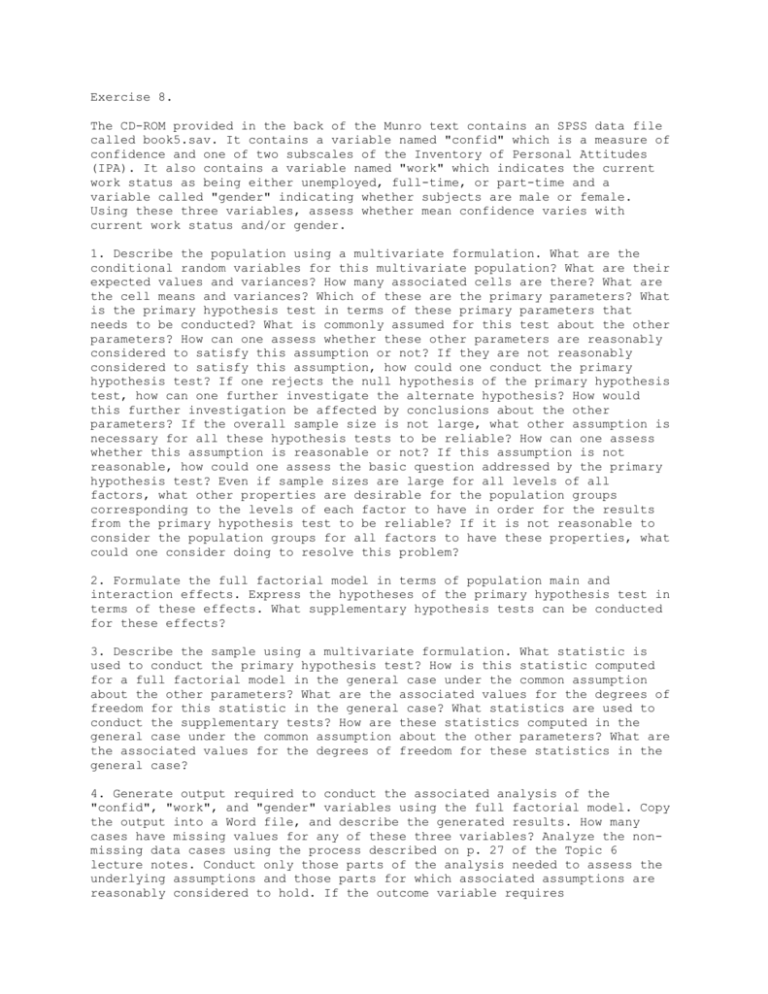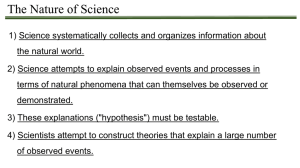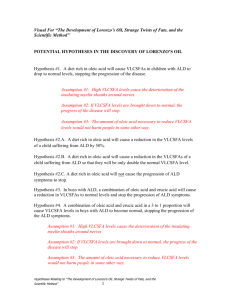Exercise 5
advertisement

Exercise 8. The CD-ROM provided in the back of the Munro text contains an SPSS data file called book5.sav. It contains a variable named "confid" which is a measure of confidence and one of two subscales of the Inventory of Personal Attitudes (IPA). It also contains a variable named "work" which indicates the current work status as being either unemployed, full-time, or part-time and a variable called "gender" indicating whether subjects are male or female. Using these three variables, assess whether mean confidence varies with current work status and/or gender. 1. Describe the population using a multivariate formulation. What are the conditional random variables for this multivariate population? What are their expected values and variances? How many associated cells are there? What are the cell means and variances? Which of these are the primary parameters? What is the primary hypothesis test in terms of these primary parameters that needs to be conducted? What is commonly assumed for this test about the other parameters? How can one assess whether these other parameters are reasonably considered to satisfy this assumption or not? If they are not reasonably considered to satisfy this assumption, how could one conduct the primary hypothesis test? If one rejects the null hypothesis of the primary hypothesis test, how can one further investigate the alternate hypothesis? How would this further investigation be affected by conclusions about the other parameters? If the overall sample size is not large, what other assumption is necessary for all these hypothesis tests to be reliable? How can one assess whether this assumption is reasonable or not? If this assumption is not reasonable, how could one assess the basic question addressed by the primary hypothesis test? Even if sample sizes are large for all levels of all factors, what other properties are desirable for the population groups corresponding to the levels of each factor to have in order for the results from the primary hypothesis test to be reliable? If it is not reasonable to consider the population groups for all factors to have these properties, what could one consider doing to resolve this problem? 2. Formulate the full factorial model in terms of population main and interaction effects. Express the hypotheses of the primary hypothesis test in terms of these effects. What supplementary hypothesis tests can be conducted for these effects? 3. Describe the sample using a multivariate formulation. What statistic is used to conduct the primary hypothesis test? How is this statistic computed for a full factorial model in the general case under the common assumption about the other parameters? What are the associated values for the degrees of freedom for this statistic in the general case? What statistics are used to conduct the supplementary tests? How are these statistics computed in the general case under the common assumption about the other parameters? What are the associated values for the degrees of freedom for these statistics in the general case? 4. Generate output required to conduct the associated analysis of the "confid", "work", and "gender" variables using the full factorial model. Copy the output into a Word file, and describe the generated results. How many cases have missing values for any of these three variables? Analyze the nonmissing data cases using the process described on p. 27 of the Topic 6 lecture notes. Conduct only those parts of the analysis needed to assess the underlying assumptions and those parts for which associated assumptions are reasonably considered to hold. If the outcome variable requires transformation, consider for simplicity only the square root and square transforms and analyze the better of those 2 transformed outcome variables whether or not it is appropriate to do so. Present hypotheses, results of testing those hypotheses, and a final summary of the conclusions in terms of the underlying problem. 5. Formulate the associated additive model. Express the hypotheses of the primary hypothesis test in terms of the effects of this model. What supplementary hypothesis tests can be conducted for these effects? What statistic is used to conduct the primary hypothesis test? How is this statistic computed for the additive model in the general case under the common assumption about the other parameters? What are the associated values for the degrees of freedom for this statistic in the general case? What statistics are used to conduct the supplementary tests? How are these statistics computed in the general case under the common assumption about the other parameters? What are the associated values for the degrees of freedom for these statistics in the general case? 6. Generate output required to conduct the associated analysis of the "confid", "work", and "gender" variables using the additive model. Copy the output into a Word file, and describe the generated results. Analyze the nonmissing data cases using the process described on p. 27 of the Topic 6 lecture notes. It is not necessary to duplicate parts of this analysis conducted as part of Question 4, but indicate what those results were. Conduct only those parts of the analysis needed to assess the underlying assumptions and those parts for which associated assumptions are reasonably considered to hold. Present hypotheses, results of testing those hypotheses, and a final summary of the conclusions in terms of the underlying problem. 7. Complete the exercises on pages 17 and 26 of the Topic 6 lecture notes. Submit completed copies of these pages in class on the due date.







